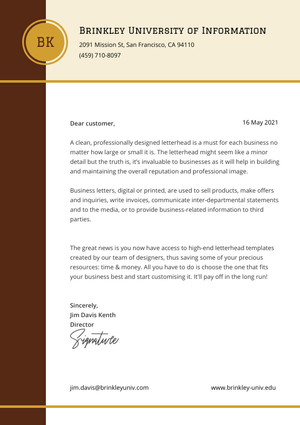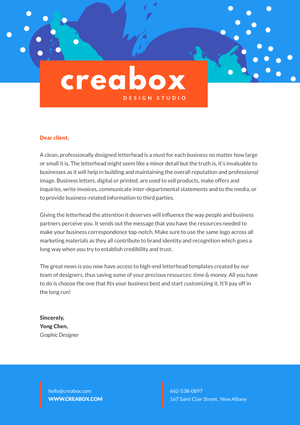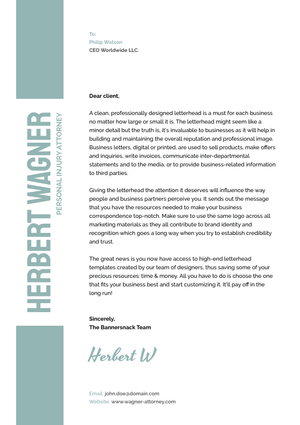Although it’s often optional and by no means the silver bullet when it comes to getting ahead in your career, a simple cover letter is a useful tool to have up your sleeve.
Research suggests that more than half of employers favor resumes accompanied by a cover letter, so it’s definitely far more than a pure formality.
Job hunting is a race where having the edge over the competition pays off.
Not all candidates will go through the trouble of writing a job application cover letter, so if you go the extra mile, you’ll certainly increase your chances to get noticed.
If you want to add this component to your job-search strategy, this article is for you.
We’ll take a look at some eye-catching free cover letter templates that you can customize to your liking and also delve into the technicalities of writing a good cover letter.
But first things first.
What Is a Cover Letter?
Simply put, a cover letter is a one-page introduction.
Think of it as a teaser for your job application that you write as a means to stand out and get the person evaluating your job application interested in reading further and—ultimately—meeting you for a job interview.
It should serve as a human touch to the otherwise fact-heavy resume.
You should attach the best cover letter to fit the role and the expectations each time you apply for a new job unless, of course, there are clear instructions not to send one.
14 Resume Cover Letter Examples
Form and content go hand in hand when it comes to creating a professional cover letter.
Samples and templates are the easy way to handle the former, regardless of your level of experience with design and layout editing software.
Check out these free customizable cover letter templates and find even more in your Creatopy account where you can personalize them down to the finest detail.
Here are a few ideas you can get inspired by.
1. Make a name for yourself
Oh wait, you already have one… Well then, what are you waiting for?
Make it shine! The challenge in getting through the first screening of any hiring process is to get the recruiters to remember you.
Update the section to this: Chewing through a pile of resumes is a straining job, especially if they all look the same. Using a free resume builder can help candidates create standout resumes that grab attention.
Building the entire design of your cover letter around your name is one way to stand out. You can transform the header into an impactful business card, or keep it clean and use a stylish monogram that makes your name super-memorable.
2. Make a statement with a vibrant color
Your resume and cover letter can stand out from the crowd even before anyone reads them.
Of course, it’s your experience and personality that will make or break it at the end of the day. However, an eye-catching design is a way to ensure your application is the first one they read and creates a lasting visual impression.
And there you have it, you’re halfway through the door.
There’s more than one way to skin this cat too.
If you want to make a bold statement, you can use the header and footer areas to their full potential, but it’s often enough to add just a few touches of vivid color for that extra oomph.
3. Choose a smart color combo
You can combine multiple colors to achieve the desired effect, but choose your color palette wisely.
You don’t have to improvise either and to be honest, it’s not advised.
Combining colors is a slippery slope, but thankfully, enough research went into it over the millennia to boil down the essence into some basic rules that are easy to follow.
Check out our recent article on color combinations if you need some inspiration.
Scroll to the end for a bite-size guide to color theory–it can come in handy down the road for so much more than a simple resume or cover letter design.
4. Use patterns to get yourself noticed
If a color or two just doesn’t cut it for you, it might be a good idea to start looking into shapes and patterns.
Who said a cover letter sample must be low-key?
A modest design can go a long way, but sometimes you want that extra kick to make it really shine.
Same as with most other design approaches, you can turn up the dial as high as you’re comfortable with.
You can keep a simple color palette with basic shapes to add a subtle accent or unleash utter chaos to make your cover letter scream “pick me” from afar.
5. Turn their heads
Metaphorically, of course.
But since the point is to make them look twice, why not turn their heads literally? When dealing with written text, it’s easiest to think in horizontal lines.
That’s what most people do anyway. And this is really not the time to be like most people.
Choose any cover letter sample for your job application and play around with the design elements.
Sometimes a few diagonal lines make all the difference but don’t be afraid to think outside the box. Just don’t forget the golden rule that less is more—choose one angle and stick with it. Otherwise, you’ll risk overdoing it.
6. Frame your achievements
Again, literally.
Other than the fact that it’s visually pleasing, a frame can give any text a sense of purpose and maturity.
Even though these are generally one-page documents, trust me, the recruiters will appreciate the visual cue to where your cover letter starts and ends.
Especially after having read dozens of them.
Steer clear of fully closed frames, though, because those will almost inevitably make your job application letter look overwhelming.
Leave it open from two sides, or at the very least one, in which case it’s best to avoid touching lines to free up the corners.
7. What’s your background?
Breathe, this is not the interview yet. But the question is just as relevant.
The background is an easily overlooked aspect of any text document, but it has enormous potential.
A well-chosen color in itself can set the tone, but a discreet shape or pattern can also make a huge difference, even if it’s barely visible.
This is not to say ignore the simple cover letter samples with a modest white background, but you can always go for soft pastel colors.
The idea is not to forget about the background because there’s a lot of surfaces to get creative with, so a conscious decision can really make a difference.
How to Write a Cover Letter
So far, designing your application letter sample has been fun and games, but now comes the really tricky part.
The content.
The bad news: there is no secret recipe as to what your cover letter should look like or the information you should include.
The good news: while we can’t tell you what to write, we can definitely help get your gears turning and give you some tips to make your job easier.
There are specific rules of thumb to keep in mind, chief among which is pragmatism.
Quite simply because every employer wants pros on their team.
Your cover letter should transmit that you mean business, so whatever you do, make sure it’s visually organized, and it’s also orderly in its presentation of information.
It also doesn’t hurt if it matches the company and the industry you’re applying to in its design as well as its tone of voice.
The most successful cover letters are built something like this:
- A memorable, engaging intro
- Specific and well-organized examples of relevant work experience
- Brief conclusion with a clear call-to-action
In essence, your cover letter should be a carefully laid-out selection of stories from your career that paints a clear image of who you are and what you bring to the table.
Here are some best practices to follow when wording your letter of intent:
- Address the recruiter by name. This may be a challenge, but no one I know is called Whom it may concern, so avoid that depersonalized formula.
- Give a relevant example from your career. Show how you solve specific problems and make it obvious that you can perform under pressure. (Not the Queen song–hold that one for the team karaoke once you’re hired)
- Use an appropriate tone of voice. Do some research to get a feel for the way the company communicates. Whatever the style, though, always be honest.
- Tell your story. It’s all about you, after all, so own it and be original.
- End with a call to action. Remember, you mean business, so make sure they know you really want to hear back from them.
What to include
Keep in mind that you have limited space and a short attention span to work with.
So keep it short and easy to follow, and in any case, make sure your cover letter includes clear information that gives a positive answer to these three questions:
- Does your work experience meet the company’s requirements?
- Do you have the skills to do the work at the level they’re expecting?
- Are you motivated to get the job?
What to leave out
Don’t try to fit your whole career into a one-page letter.
First, because you have the resume for that.
And second, because it wouldn’t be possible anyway.
However, other than cutting the fluff, there are two common mistakes you should avoid:
- Never include irrelevant information. It’s okay to showcase the proudest moments of your career, but only if they’re relevant for the job. Otherwise, it’s best to resist the urge to mention them altogether.
- Avoid overused phrases. Remember, it’s all about getting yourself noticed. Lose the tired clichés and be your most original self.
Conclusion
Adding a cover letter to your resume is not always required, but that doesn’t mean it’s not a valuable tool when you’re out prepping for your next career move.
On the contrary—unless it’s explicitly stated that you shouldn’t submit one, it’s best to have it handy and update it as regularly, if not more often than your resume.
Keep it to the point, though: rather than echoing your resume, it should come as a completion of it.
I hope the tips and cover letter examples in this article will help you up your job-hunting game and put your best foot forward.
What experiences have you had with cover letters?
Have you ever landed a job, thanks to a cover letter? Did any of your employees stand out with a compelling letter of intent?
Tell us your story in the comments below.






















